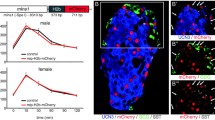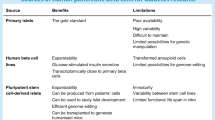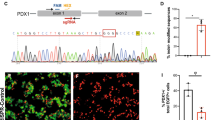Summary
Insulin secretion from pancreatic beta cells is dependent on membrane potential changes that result from the concerted regulation of multiple ion channels. Among the distinct K+ channels known to be expressed in beta cells, large conductance Ca2+-activated K+ channels have been suggested to play an important role in stimulus-secretion coupling. In the course of a strategy to identify transcripts that are enriched in human pancreatic islet cells, we isolated a partial cDNA encoding a human large conductance Ca2+-activated K+ channel mRNA (hSlo). Northern analysis of mRNA showed that among a panel of human tissues hSlo is expressed at its highest levels in pancreatic islets. Screening of human insulinoma and islet cDNA libraries with the partial cDNA resulted in the isolation of 19 hSlo cDNAs. These comprised three splice variants: one shared the common underlying structure of previously reported Slo cDNAs, another variant encoded a novel 60-amino acid insertion in the putative Ca2+-sensing domain of hSlo, while the third group of clones had an alternate exon encoding eight amino acids in the predicted COOH-terminal end. Analysis of somatic-cell hybrids containing different portions of chromosome 10 indicated that hSlo maps to chromosome 10q22.2–q23.1. Furthermore, high resolution localization was obtained by analysis of genome-wide radiation hybrids and the CEPH “B” mega-YAC library, both of which identified for the first time a highly polymorphic genetic marker (D10S195) linked to hSlo. These studies provide tools with which to explore the physiological role of Ca2+-activated K+ channel proteins in pancreatic islets, and also to investigate the contribution of this locus to the inherited susceptibility to non-insulin-dependent diabetes mellitus.
Similar content being viewed by others
Abbreviations
- NIDDM:
-
Non-insulin-dependent diabetes mellitus
- Kv :
-
voltage-gated delayed rectifier channel
- BK:
-
high conductance K+ channel
- PCR:
-
polymerase chain reaction
- RH:
-
radiation hybrid
- LOD:
-
log of the odds
- STS:
-
sequence tagged site
- SSC:
-
NaCl/sodium citrate reagent commonly used in mol. bio
References
Cook DL, Satin LS, Ashford ML, Hales CN (1988) ATP-sensitive K+ channels in pancreatic beta-cells. Spare-channel hypothesis. Diabetes 37: 495–498
Ashcroft FM, Rorsman P (1991) Electrophysiology of the pancreatic b-cell. Prog Biophys Mol Biol 54: 87–143
Misler S, Barnett DW, Gillis KD, Pressel DM (1992) Electrophysiology of stimulus-secretion coupling in human beta-cells. Diabetes 41 1221–1228
Ammala C, Larsson O, Berggren PO et al. (1991) Inositol trisphosphate-dependent periodic activation of a Ca(2+)-activated K+ conductance in glucose-stimulated pancreatic beta-cells. Nature 353: 849–852
Philipson LH, Rosenberg MP, Kuznetsov A et al. (1994) Delayed rectifier K+ channel overexpression in transgenic islets and beta-cells associated with impaired glucose responsiveness. J Biol Chem. 269: 27787–27790
Henquin JC (1979) Opposite effect of glucose and intracellular Ca2+ on K+ permeability of pancreatic islet cells. Nature 280: 66–68
Henquin JC (1990) Role of voltage- and Ca2(+)-dependent K+ channels in the control of glucose-induced electrical activity in pancreatic B-cells. Pflugers Archiv-Eur J Physiol 416: 568–572
Chay TR (1986) On the effect of the intracellular calcium-sensitive K+ channel in the bursting pancreatic beta-cell. Biophys J 50: 765–777
Kukuljan M, Goncalves AA, Atwater I (1991) Charybdotoxin-sensitive K(Ca) channel is not involved in glucose-induced electrical activity in pancreatic beta-cells. J Memb Biol 119: 187–195
Bordin S, Carneiro EM, Atwater I, Rojas E, Boschero AC (1995) Modulation of Ca2+ and K+ permeabilities by oxotremorine-M (OXO-M) in pancreatic b-cells. Diabetelogia 38[Suppl 1]:A118 (Abstract)
Philipson LH, Hice RE, Schaefer K et al. (1991) Sequence and functional expression in Xenopus oocytes of a human insulinoma and islet potassium channel. Proc Natl Acad Sci USA 88: 53–57
Yano H, Philipson LH, Kugler JL et al. (1994) Alternative splicing of human inwardly rectifying K+ channel ROMK1 mRNA. Mol Pharmacol 45: 854–860
Ferrer J, Nichols CG, Makhina EN et al. (1995) Pancreatic islet cells express a family of inwardly rectifying K+ channel subunits which interact to form G-protein activated channels. J Biol Chem 270: 26086–26074
Porte DJ (1991) Banting lecture. Beta-cells in type II diabetes mellitus. Diabetes 40: 166–180
Tseng-Crank J, Foster C, Krause J et al. (1994) Cloning, expression, and distribution of functionally distinct Ca2+-activated K+ channel isoforms from human brain. Neuron 13: 1315–1330
Butler A, Tsunoda S, McCobb DP, Wei A, Salkoff L (1993) mSlo, a complex mouse gene encoding “maxi” calcium-activated potassium channels. Science 261: 221–224
Pallanck L, Ganetzky B (1994) Cloning and characterization of human and mouse homologs of the Drosophila calcium-activated potassium channel gene, slowpoke. Hum Mol Gen 3: 1239–1243
McCobb D, Fowler N, Featherstone T, Lingle CJ, Saito M, Krause JE, Salkoff L (1995) A human calcium-activated potassium channel gene expressed in vascular smooth muscle. Am J Physiol 38:H767-H77
Atkinson NS, Robertson GA, Ganetzky B (1991) A component of calcium-activated potassium channels encoded by the Drosophila slo locus. Science 253: 551–555
Garcia CM, Knaus HG, McManus OB et al. (1994) Purification and reconstitution of the high-conductance, calcium-activated potassium channel from tracheal smooth muscle. J Biol Chem. 269: 676–682
Ferrer J, Schoor K, Wasson J, Kipnis D (1994) Identification of 5 human islet-specific genes by differential display of mRNA. Diabetes 43[Suppl 1]:6A (Abstract)
Atwater I, Mears D, Rojas E (1996) Electrophysiology of the pancreatic b-cell. In: LeRoith D, Olefsky JM, Taylor S (eds) Diabetes mellitus: a fundamental and clinical text. Lippincott
Maniatis T, Fritsch EF, Sambrook J (1989) Molecular cloning: a laboratory manual. Cold Spring Harbor Press, Cold Spring Harbor, N.Y.
Liang P, Pardee AB (1992) Differential display of eukaryotic messenger RNA by means of the polymerase chain reaction. Science 257: 967–971
Permutt MA, Koranyi L, Keller K et al. (1989) Cloning and functional expression of a human pancreatic islet glucose-transporter cDNA. Proc Natl Acad Sci USA 86: 8688–8692
Altschul SF, Gish W, Miller W, Myers EW, Lipman DJ (1990) Basic local alignment search tool. J Mol Biol 215: 403–410
Chiu KC, Province MA, Permutt MA (1992 Glucokinase gene is genetic marker for NIDDM in American blacks. Diabetes 41: 843–849
Cox DR, Burmeister M, Price ER, Kim S, Myers RM (1990) Radiation hybrid mapping: a somatic cell genetic method for constructing high-resolution maps of mammalian chromosomes. Science 250: 245–250
Astrin K, Warner C, Yoo H et al. (1991) Regional assignment of the human uroporphyrinogen III synthase (UROS) gene to chromosome 10q25.2–26.3. Hum Genet 87: 18–22
Brooks-Wilson A, Smailus D, Weier H, Goodfellow P (1992) Human repeat element-mediated PCR: cloning and mapping of chromosome 10 DNA markers. Genomics 13: 409–414
Cohen D, Chumakov I, Weissenbach J (1993) A first-generation physical map of the human genome. Nature 366: 698–701
Murell V (1993 The puzzle of triplet repeats. Science 260 1422–1423
Lagrutta A, Shen KZ, North RA, Adelman JP (1994) Functional differences among alternatively spliced variants of Slowpoke, a Drosophila calcium-activated potassium channel. J Biol Chem 269: 20347–20351
Wei A, Solaro C, Lingle C, Salkoff L (1994) Calcium sensitivity of BK-type K Ca channels determined by a separable domain. Neuron 13: 671–681
Atwater I, Rosario L, Rojas E (1983) Properties of the Ca-activated K+ channel in pancreatic beta-cells. Cell Calcium 4: 451–461
Rorsman P, Trube G (1986) Calcium and delayed potassium currents in mouse pancreatic b-cells under voltage clamp conditions. J Physiol (London) 374: 531–550
Eddlestone GT, Ribalet B, Ciani S (1989) Comparative study of K channel behavior in beta cell lines with different secretory responses to glucose. J Memb Biol 109: 123–134
Kume H, Kotlikoff MI (1991) Muscarinic inhibition of single K Ca channels in smooth muscle cells by a pertussis-sensitive G protein. Am J Physiol 261: C 1204-C 1209
Author information
Authors and Affiliations
Rights and permissions
About this article
Cite this article
Ferrer, J., Wasson, J., Salkoff, L. et al. Cloning of human pancreatic islet large conductance Ca2+-activated K+ channel (hSlo) cDNAs: evidence for high levels of expression in pancreatic islets and identification of a flanking genetic marker. Diabetologia 39, 891–898 (1996). https://doi.org/10.1007/BF00403907
Received:
Revised:
Issue Date:
DOI: https://doi.org/10.1007/BF00403907




